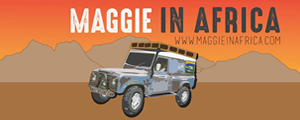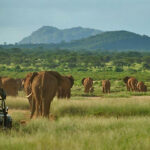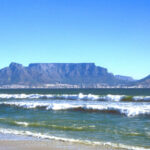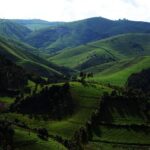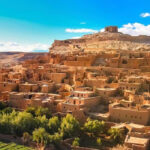Pretoria – nicknamed the ‘Jacaranda city’ for the thousands of Jacaranda trees that line the streets of the city – is not often considered one of South Africa’s ‘must-see’ urban destinations, especially in comparison with Cape Town or Johannesburg.
But the city has a mix of historical, outdoor and cultural experiences that makes it an awesome attraction in its own right.
And because Pretoria has the second largest number of diplomatic missions in the world, with a robust 4×4 community, it’s a perfect place for overlanders to stop to organise visas or for some outfitting TLC.
Noel and I have spent the last two weeks here while Maggie gets prepared for the big journey at British 4×4, and have so far not struggled to find new and exciting things to do.
Ok, you don’t need a whole month to enjoy most of what Pretoria has to offer. But we’ve compiled the following list of our favourite things that we’ve done so far.
1. Spend a day at the Freedom Park
- Entrance to Freedom Park
- //hapo Museum display
- Garden of Remembrance
- Wall of Names
Visiting Pretoria’s impressive Freedom Park was by far our favourite ‘day out’ during our stay in the city – and the site can definitely give Johannesburg’s Apartheid Museum a run for its money. We arrived in the afternoon, and regretted not being able to spend a whole day exploring the //hapo Museum and Garden of Remembrance, and the gardens and footpaths that connect the two.
And no, that’s not a typo. “//hapo” means “dream” in Khoi, a hommage paid to South Africa’s indigenous history.
The //hapo Museum, by far the city’s most well-presented, ambitiously covers 3.6 billion years of African history from an African perspective. The exhibits are divided into seven eras, starting with the creation of Earth, and passing through indigenous human history, colonisation, apartheid, the freedom struggle and finally, modern day.
In contrast to the museum, the Garden of Remembrance is a more tranquil and reflective place to spend a couple of hours. The garden commemorates those that played a role in the struggle for South Africa’s freedom, and includes a number of monuments, statues and sculptures spread out over a beautiful outdoor landscape. Our favourite was the Wall of Names (pictured above), on which are inscribed the names of those who died in various conflicts for South Africa’s freedom.
Entrance fee: R100 for non-South Africans; gets you into both the museum and gardens.
2. Get back to your human roots at the Cradle of Humankind
Ok, so this one isn’t technically in Pretoria. But it’s just 1.5 hours away, and we had to include it on our list because it’s just too good.
The Cradle of Humankind is one of South Africa’s eight World Heritage Site, and its network of limestone caves are home to one of the largest sources of early hominid fossils in the world. There have been many famous fossil finds at the site, including Mrs. Ples, the most complete skull of an Australopithecus africanus ever found.
Although there are many areas of excavation within the site, rather confusingly marked on the road sides, only two areas are open to the public: the Maropeng exhibition and visitors centre, which is an engaging museum, and the Sterkfontein caves, which can be explored on a guided tour. We found both to be extremely interesting, well-presented and accessible – highly recommended!
And if the many fossil exhibits at the Maropeng centre aren’t enough, follow up the next day with a visit to the Ditsong Museum of Natural History in Pretoria to visit the real Mrs. Ples fossil in the flesh (no pun intended). But unfortunately, as we discovered, that’s the only reason you’ll want to visit the rather outdated and neglected museum.
Entrance fee: R190 for both the museum and caves.
3. Picnic with Mandela at the Union Buildings
Pretoria is one of South Africa’s three capital cities, along with Cape Town and Bloemfontein, and is where the President and executive branch sit in the impressive Union Buildings.
While not open to the public, the imposing sandstone buildings, designed in the English monumental style with Cape Dutch features, symbolically represent the coming together of the British and Afrikaans to form the Union of South Africa.
The buildings also happen to sit at the highest point of Pretoria and are surrounded by beautiful, terraced gardens. So pack a lunch, and enjoy the view under the watchful gaze of a nine-metre tall statute of former president Nelson Mandela.
Entrance fee: FREE 
4. Stop to smell the roses in the Botanical Gardens

Waterfall at Pretoria Botanical Gardens
Ok, so we didn’t see any roses at the Pretoria National Botanical Gardens. But we definitely enjoyed a long afternoon meandering through the nature trails, breaming with indigenous vegetation and nearly 200 bird species.
There are 76 hectares of gardens to explore, organised into a number of habitats, from woodlands and wetlands. All are managed by the South African National Botanical Institute (SANBI). And for those who are super interested in plant life, stop by the Herbarium for a tour of the centre’s 2 million+ specimens of indigenous flora.
Don’t take your picnic to this one though – we recommend stopping for a bite to eat and a refreshing drink at the Milkplum cafe, next to the waterfalls, or the African Pride cafe, overlooking the wetlands. And if you’re lucky (which we weren’t), you might arrive on a live concert day, so pack your dancing shoes.
Entrance fee: P26 per adult.
5. Go on an urban safari
Yes, that’s right. A game drive in the big city.
Unlike many of South Africa’s other major cities, Pretoria is chock full of game and nature reserves. So you don’t even need to leave the city to enjoy wildlife or take in your natural surroundings. There are so many options within, and a short distance outside of, the city, but here are our top pics.
Rietvlei Nature Reserve

Rhinos in the Rietvlei Nature Reserve (courtesy of Andesine)
Only 18km from the city centre, the Rietvlei Nature Reserve is the largest urban game reserve in Africa, and offers a number of activities, including game drives, hiking trailings, horse riding and fishing. It’s also home to wildlife, including the protected rhino, zebra, eland, and springbuck. You can self-drive or take a game drive offered by the reserve.
Entrance fee: R48 per adult.
Groenkloof Nature Reserve

Giraffes in the Groenkloof Nature Reserve (courtesy of Crystian Cruz)
The Groenkloof Nature Reserve, located just 5km outside of Pretoria, is said to be Africa’s first ever game sanctuary, established in 1895 to protect oribi from being wiped out by hunters. In addition to game viewing, the reserve is also well known for its mountain biking and hiking trails.
Entrance fee: R25 per adult.
Wonderboom Nature Reserve

1,000 year-old fig tree at the Wonderboom Nature Reserve (courtesy of Dean Jones)
Located north of Pretoria in the Mageliesberg mountain range, the Wonderboom Nature Reserve is perhaps best known for its 1,000 year old Wonderboom fig tree. There are also hiking trails, leading to the ruins of Wonderboom Fort, built before the second Anglo-Boer War. And don’t forget the game viewing, including zebra, impala and the rock hyrax.
Entrance fee: R31 per adult.
6. Visit Pretoria’s National Zoo

Okapi in the national zoo, Pretoria (courtesy of John Karwoski)
“Why visit a zoo in Africa?” one might ask.
Well, for starters, because Pretoria’s National Zoological Gardens is the largest zoo in South Africa and home to more than 8,000 species of animals, reptiles, fish and birds. The zoo also hosts education and research programmes, which makes it an important institution for conservation efforts.
We particularly enjoyed visiting the Scimitar-horned Oryx and Okapi (pictured above), both of which are currently extinct in the wild. Now you can’t see that at Kruger!
Entrance fee: R95.00 per adult.
7. Enjoy the Austin Bird Sanctuary from the Blue Crane Restaurant

Deck of the Blue Crane Restaurant, courtesy of their Facebook page
Get out of the city without getting out of the city at the Austin Bird Sanctuary in Muckleneuk. The sanctuary is nearly 12 hectares of wetlands, home to over 170 species of bird, including the elegant blue crane and Egyptian goose.
And on its banks sits the aptly named Blue Crane Restaurant, which boasts a sun deck with unbeatable views. On Sundays, the breakfast and lunch buffets are not to be missed. We love this place!
Average cost of meal & drink is R100 per person.
8. Voortrekker Monument
Located just south of Pretoria is the Voortrekker Monument, one of the city’s most frequently visited sites. A rather eery and mason-esque granite structure built on a hilltop, the monument and museum underneath commemorate the Afrikaans ‘pioneers’ (voortrekkers) who left the Cape Colony for the Transvaal in the early-t0-mid 1800s.
Although revered by the Afrikaans as testament to their history, culture and survival, we found that the museum beneath offered a rather colonial and Euro-centric view of South Africa’s history. But, then again, we did visit the Freedom Park on the same day, and both sites certainly offer competing historical perspectives.
The view from the top of the monument was potentially the most impressive feature, especially because the domed roof is designed to let the sun hit the centograph in the basement at precisely noon on the anniversary of the Battle of Blood River (16 Dec) between the Voortrekkers and Zulu.
Entrance fee: R60 per adult.
9. Enjoy a local brew at the Capital Craft Beer Academy

Courtesy of Capital Craft Beer Academy
In our opinion, you cannot possibly experience a place until you taste the local brew.
And that’s exactly what’s on offer at the Capital Craft Beer Academy in Menlo Park, which boasts an extensive selection of South African and international craft beers, ciders and liquors. Order something to eat as well, and we promise you won’t be disappointed!
Average cost of meal & drink is R100 per person.
10. Go to the Market

Hazel Food Market, Pretoria (courtesy of Hazel Food Market)
If you’re looking for a break from the supermarket, attend the Hazel Food Market (Saturdays 8am-1pm). This trendy and authentic Saturday-morning food market in Menlo Park specialises in local produce, as well as international and cultural fare.
Or if you’re looking for a break from the shopping malls, try the Hatfield Flee Market (Sundays from 9am-5pm). This market boasts over 200 stalls selling a wide variety of merchandise, including antiques, clothing, decor, arts and crafts, and jewellery. Make sure to stop by the food court for some great local fare.
